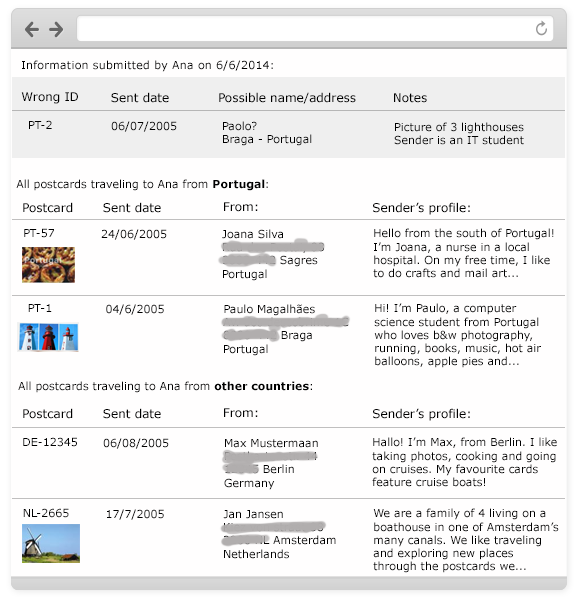On the last behind-the scenes post, many of you asked how do we find missing Postcard IDs. Well… I’m afraid the answer is pretty straightforward: for every help request you submit, we compare the information you provide us about the postcard you’ve just received with all the information we have about the postcards currently traveling to you until we find a match.
There aren’t any magic tricks for this one – it’s just a matter of patience and sharp Sherlock-skills!
Let’s see how it works in practice. Imagine it’s 2005 and someone named “Ana” has just received a cute postcard from Portugal with some lighthouses… but sadly, the Postcard ID is wrong, and she cannot register it. She knows what to do though, and promptly submits a request for help with her unknown Postcard ID!
On Postcrossing’s back office, a page is created for her help request. It looks a bit like this:

This page is only seen by us, the members of the Postcrossing team, and contains all the information we might need to find the right postcard ID.
On the top of the page, you see all the information Ana just submitted about the postcard: it features 3 lighthouses, was sent around July 6th, from someone named “Paolo” from Braga, Portugal, who mentions he’s an IT student.
Then, below that, a neat little table is displayed with all the postcards traveling to Ana. For instance, you can see she has quite a few postcards traveling to her at the moment: a few from Portugal (shown first, since they are most likely to match), one from Germany and one from the Netherlands.
Can you guess the right postcard ID for the card Ana received? Given all this data… it’s not that complicated, right? You just need to compare the information available to spot the correct postcard ID!
So it looks like PT-1 is the postcard ID she was looking for: the ID is very close to the right one, the name and location match, the picture the sender uploaded seems to fit… now all is left is to let the recipient know this information, which we do by clicking a button.
If enough information is provided, Postcrossing can sometimes automatically find the right postcard ID, but most of the time, things aren’t so simple — that’s where Vicki steps in. She goes over nearly 1000 requests every week, going after the really tricky cases and doing some remarkable detective work to make sure all postcards are registered. It’s a very time-consuming process, but a very important one as well, which minimizes frustration all-around.
So… what are the most common problems she has to deal with?
Most of the time, simple stuff: digits are out of order, a 7 looks like a 1, a number might be missing, someone wrote the ID of the next card they requested or there might be some confusion regarding country codes (CN≈CH, AU≈AT). Sometimes, in the excitement of sending off a postcard, someone will just forget to write down the postcard ID. Given enough information, the answer is usually straightforward.
But there are trickier cases — like when you receive a card from a private swap which you completely forgot about! Or when members don’t realize that the postcard they received was actually sent to a roommate or family member living in the same address… in which case, every family member should submit a request.
A few postcards do arrive after traveling for over 1 year… in which case they cannot be registered.
What helps? Here are some tips on how you can help make a search for a Postcard ID more efficient:
- Describe the image on the front of the postcard you’ve received in as much detail as possible! If your description matches an image the sender has pre-uploaded, the search for the right Postcard ID will definitely be easier.
- Can’t make out the exact name of the sender? Have a guess from the signature. Even if you write it incorrectly, we’ll probably be able to figure it out.
- Look closely to the stamp and cancellation mark. Where and when was this card posted?
- Does the postcard describe the sender, eg. what they do for a living, where they live, whether this is the first postcard they send? If so, include these on your help request!
- Submit just one request per postcard received. If you want to add more information to it, just delete the request (you can do this on your Received postcards page) and re-submit it with all the information.
To prevent this situation, here are some tips of things you should do, which will definitely help your cards get registered in case something goes wrong:
- Try to write the Postcard ID with a pen with water-resistant ink, so that it cannot be washed away if the card gets wet.
- Write the Postcard ID on the left side of the card, and at least in two different places.
- If this is a card for a private swap, or a thank you card – mention this on the postcard, so that the recipient does not confuse it with a Postcrossing card!
Every time a help request is submitted, the status of the search will show on your Received Postcards page. If it says “Searching”, then it is still in the queue and will be answered as
soon as possible. If you manage to find out the right postcard ID before we gave it to you – congratulations, you must be a smart cookie! :) Just don’t forget to delete your request for help on the Received Postcards page.
Finally, it seems many people are still unaware that they can ask for help searching a Postcard ID… so if you see any pleas for help on members’ profiles, just pass on the knowledge and share the link to our special form, deal?




